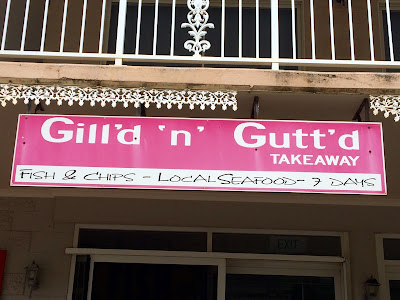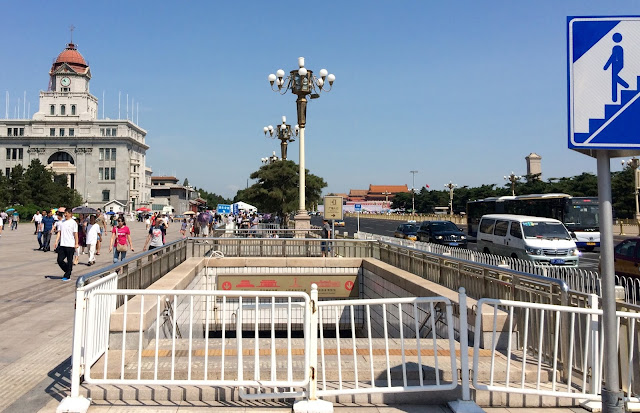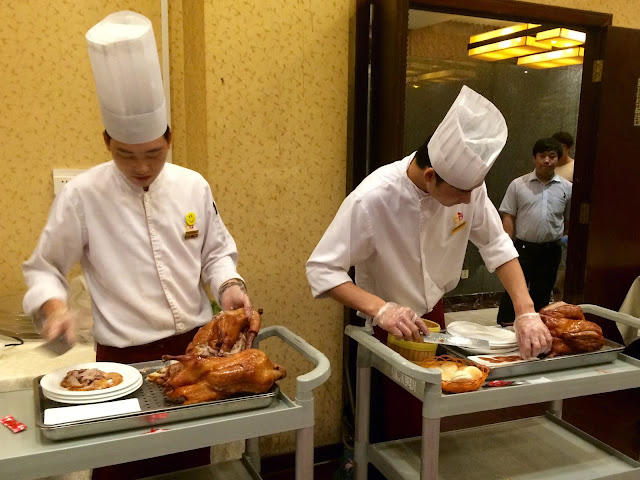 |
| Hong Kong's Cooked Food Centres are typically found in Municipal Buildings |
 |
Massive municipal buildings with utilitarian
architecture house Hong Kong's many markets |
Food is omnipresent in Hong Kong. When Jeff and I first learned that we would be moving here, one of the most common reactions we heard was "You will love the food." Indeed, there are many aspects to Hong Kong's culinary culture, but a prominent feature is its vast restaurant industry. It is difficult to walk down the street in Hong Kong without encountering some form of eating place, ranging from modest food stalls on the street to high-end dining establishments branded and overseen by a celebrity chef.
The combination of cramped housing and lengthy work hours for the average employee (a 45+ hour week is typical) mean that food prepared away from home is a popular choice for most Hongkongers. Restaurants thrive here and are typically full, with lengthy lines formed in front of them at peak lunch or dinner hours. Take-out containers are a common site, whether loaded on the back of a motor scooter or dangling from the arms of a courier running between buildings.
 |
| Food deliveries are a common sight on Hong Kong streets |
During early years under British rule, Hong Kong's culinary culture was highly segregated, with little crossover between the traditional, peasant style cuisine consumed by the local population and the Western-style cuisines favored by a growing expatriate community. The restaurant industry began to grow in response to the need for business entertainment among the elite. Restaurants even featured prostitutes and opium until just before World War II broke out. To the north, Guangzhou (formerly known as Canton) was the home of Cantonese cuisine, and its close proximity heavily influenced Hong Kong's culinary scene.
 |
| Couriers deliver food to the many office buildings in Central Hong Kong |
When the Communist Party came to power in 1949, an influx of refugees from the Yangtze River Delta introduced Shanghai cuisine into Hong Kong, a style that remains popular here today. Eventually, Hong Kong became the epicenter of Cantonese cuisine when Guangzhou's influence and sophistication declined after years under Communist rule.
 |
Traditional street stalls or Dai Pai Dong
are still popular but declining in numbers
|
The flood of refugees from the Mainland in the early 1950s put significant pressure on the tight housing supply in Hong Kong. As a solution to the lack of cooking space in their cramped living spaces, residents turned to outdoor food stalls which had been operating in Hong Kong without licensing since the late Nineteenth Century. Around the end of World War II, the government set up a licensing system to monitor the growing industry and control hygiene standards. The licenses that were issued were larger in size than those issued to other hawker stalls, so the food stalls became known as
Dai Pai Dong, which means "restaurant with a big license plate."
 |
| Food is prepared in an open-air kitchen in Dai Pai Dong |
Throughout the 1950s, Dai Pai Dong grew in popularity as neighborhood gathering places for the working class to get affordable, homestyle meals of rice or noodles. But complaints about noise, traffic congestion, lax hygiene and even black market activity began to emerge as the popularity of Dai Pai Dong peaked. In 1956, the government stopped issuing new licenses and restricted licensees' ability to transfer their licenses. Subsequent efforts to eliminate Dai Pai Dong included buybacks and other incentives to surrender the licenses. At their peak, more than 800 Dai Pai Dong existed in Hong Kong, but by 2014, the number had dropped to about 25. A mini-documentary called
The Fading Spirit of Dai Pai Dong is a tribute to the history of the food stalls. Today, concerns about the loss of tradition represented by Dai Pai Dong have loosened some of the restrictions on transferring the licenses, and efforts are underway to preserve the few Dai Pai Dong that remain.
 |
Many traditional Dai Pai Dong moved into Cooked Food Centres,
where the authorities could exercise more control over their operation |
During the 1970s, many of the Dai Pai Dong moved to one of the 25 Cooked Food Centres (CFC) around Hong Kong. These centers are typically part of larger food markets that occupy hulking public buildings, sometimes alongside other government operations, such as libraries and sports or recreation centers. Today, there are 76 Public Markets in Hong
Kong, and they are managed by the Hong Kong government's Food and Environmental Hygiene department. Ironically, the markets are ugly tile and concrete multi-story buildings that house their culinary treasures in a very modest atmosphere. Many are organized like the classic food chain, with produce stalls on the ground floor, followed by meat, poultry and fish one level up. At the top of that food chain, one finds the Cooked Food Centre where the humans sit down for a meal. In some markets, purchases from the lower floors can be brought to the CFC to be prepared and served by one of the food stalls.
 |
A market directory showing meat, fish and produce stalls on the lower
floors of the market and the Cooked Food Centre on the top floor |
In a city filled with expats and foreigners, CFCs are one of the most "local" experiences a person can have. Wobbly, folding tables are surrounded by plastic stools for seating and topped with large plastic glasses stuffed with chop sticks and and array of bottles of chili sauce, giving CFCs a certain charm. Seating is communal and all of the food stalls generally share the tables and chairs in the center. In keeping with the Dai Pai Dong tradition of being a gathering place, it's not uncommon to see large groups or families lingering over a meal that can last for hours.
 |
| Fish and seafood for sale at Kowloon City Market |
CFCs are generally acknowledged to have some of the best local "Hong Kong" food around, which is usually described as a local spin on traditional Cantonese, Sichuanese, Shanghainese or other regional specialties. But since Hong Kong is essentially an international city, it's not surprising that cuisines offered in CFCs are no longer just Chinese but now include Thai, Vietnamese, Indian and even Italian, among others.
 |
| An unlucky chicken is selected for the next customer at Kowloon City Market |
In our visits to CFCs, Jeff and I are frequently the only Westerners. We enjoy strolling through the markets, occasionally attracting a curious stare. More often, though, proprietors of the various food stalls wave their laminated menus and invite us to sit down and order. Our selection criteria is pretty simple - we look for a menu translated into English and plates of food that look appetizing. Our lack of Cantonese skills have provided some amusing moments, like the time I accidentally ordered 72 Beijing style dumplings (turns out, there were twelve dumplings to each order, a fact that was omitted from the English version of the menu).
 |
| Abundant fruit stalls at Kowloon City Market |
I have to admit to a few moments of hesitation, but have never been disappointed by our meals or experiences in the CFCs. And the communal seating has allowed us to interact with fellow patrons in a variety of ways, ranging from a raised beer and a smile to patient explanations of the various food offerings, depending upon the extent of their English skills.
 |
| Communal seating adds to the adventure of eating at Cooked Food Centres |
In Hong Kong, the vastness of the food industry means that it would be nearly impossible to have a craving for something that couldn't be satisfied. In our time here, we have had the good fortune to sample foods originating from many different nations in a variety of venues ranging from modest to elegant. But our warmest memories will be of our meals at the food stalls in the Cooked Food Centres. Their Dai Pai Dong origins, the traditional Chinese fare, and the warm and friendly locals with whom we shared our tables make us happy to be among those eating at the top of the food chain.
 |
| Enjoying a moment of fellowship at the Sheung Wan Cooked Food Centre |
















































